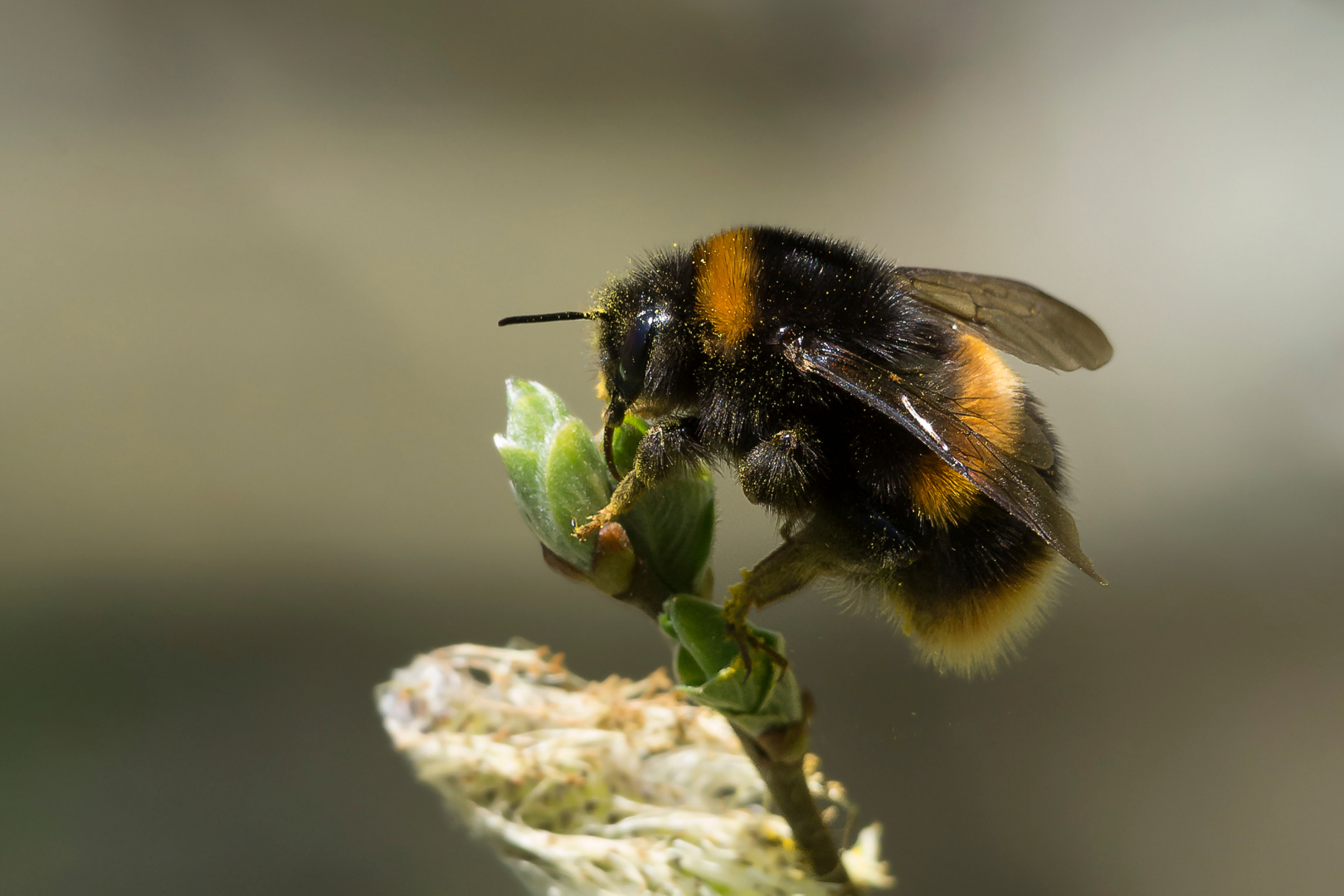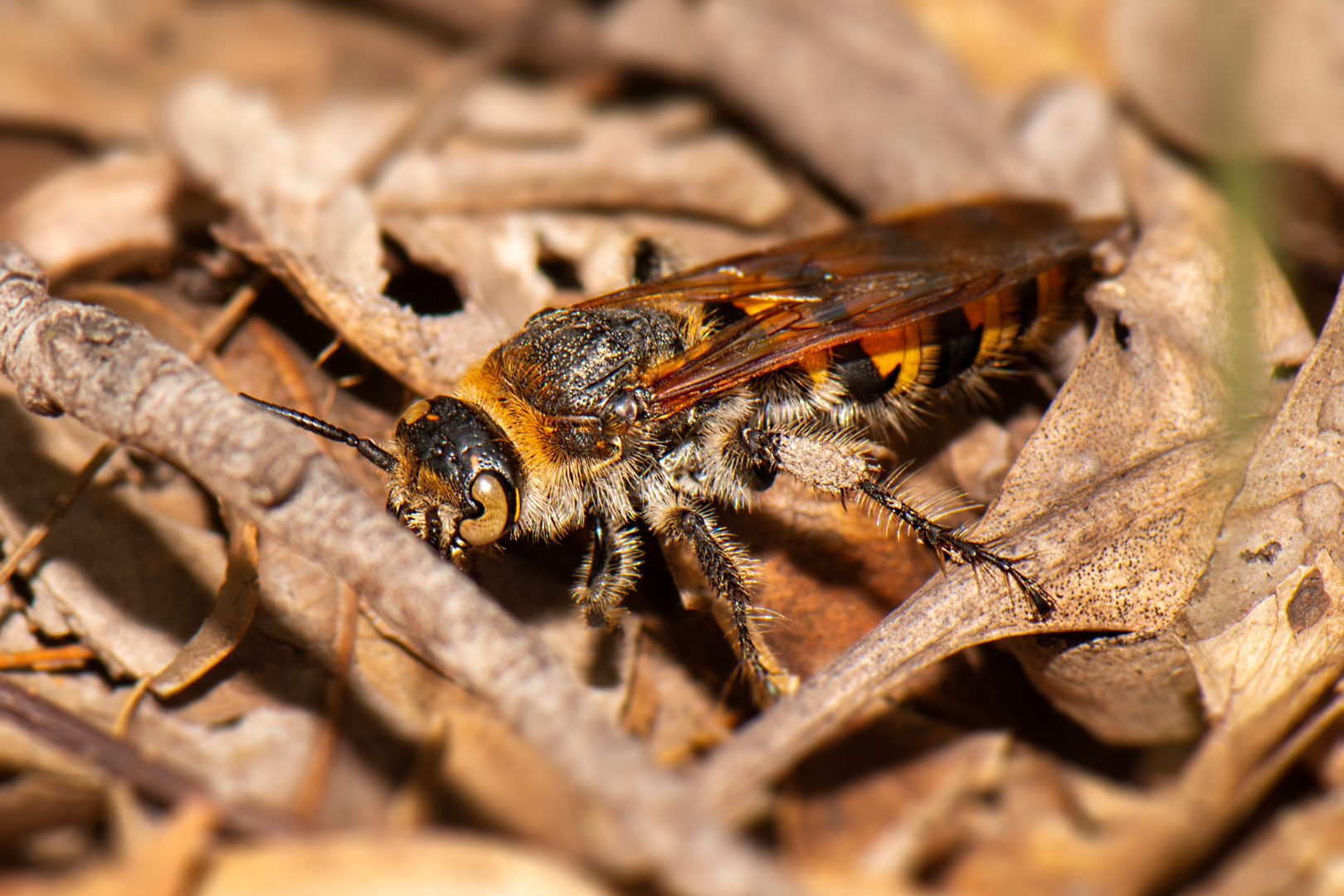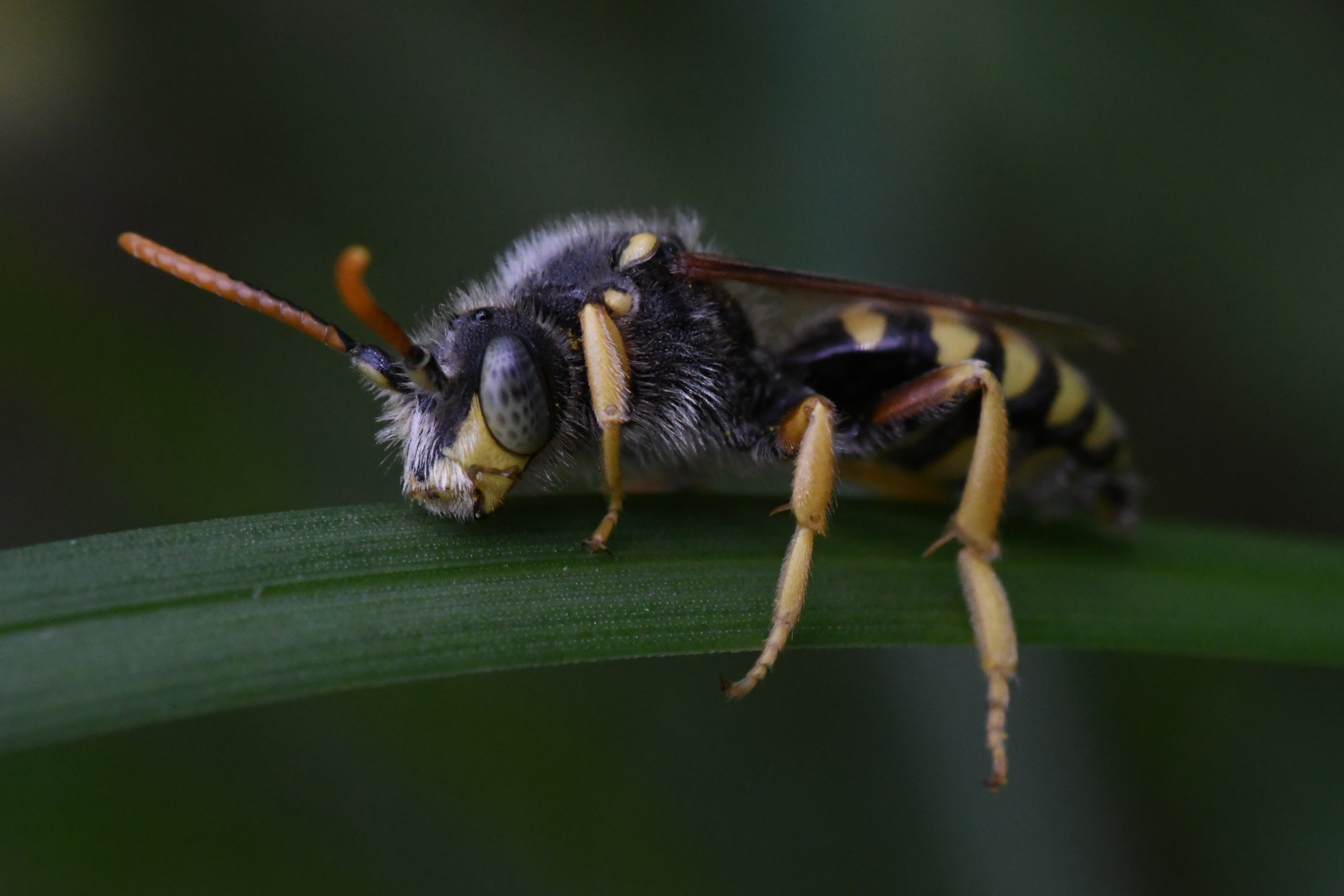
The most commonly thought of habitat for bees is a large hive hanging in a tree or slats of honeycomb from a beekeeper. However, most of the tens of thousands of bee species in the world today actually live by themselves or in solitary nests in a gregarious nesting community.
What Is Eusocial vs Solitary Nesting?
Some bee species live in a complicated system among a large community of other bees, while others nest and reproduce by themselves, though often within close proximity of other solitary nesters.
Eusocial Nesting Bees
Eusociality is a form of social behaviour that is rare in the animal kingdom, with just a few types of animals, including some bees living in this extreme, complex society with others. Eusocial behaviour is most commonly characterized by:
- Several generations living in the same nest at the same time
- Responsibilities of offspring care shared among members other than direct parents
- Distribution of labour with females reproducing and workers who do not
Honey bees and bumblebees are common species that nest in primitive eusocial structures with large numbers of other bees. These bees work together to form incredibly complex societies that construct beehives made up of a series of masterfully crafted wax honeycombs that produce large amounts of pure honey.
Solitary Nesting Bees
Most other species of bees are considered solitary nesters that live completely along or in solitary nests within a larger aggregated group. Some bees that come from the following species are considered solitary nesting bees:
- Alkali bees
- Carpenter bees
- Digger bees
- Leafcutter bees
- Mason bees
- Plasterer bees
- Sweat bees
Nesting Habits of Solitary Bees
Most bee species, including some honey bees and bumblebees, are considered solitary bees. A defining characteristic of solitary bees is that all females are fertile and able to build a nest to reproduce and raise brood. Unlike eusocial bees, there are no complex social dynamics with workers, drones, and queens.
Females are on their own to build a nest and provide for their young from egg to lava, pup, and ultimately adult. Another distinguishing factor from honey bees is that solitary bees do not produce honey or beeswax. They forage for food for themselves and their young by foraging through flowers and collecting pollen to bring back to the nest.
Solitary bees will nest either in the ground or in hollow reeds, twigs, or large enough holes in wood. When constructing the nest, the female will build a cell for an egg and the storage of food supplies for the larva before sealing the compartment off from the rest of the nest.
Some females share a communal nest featuring multiple compartments to house multiple females, though each will supply their own cells with the needed provisions for their youth. This allows the bees to defend the nest more easily from predators.

Nesting Habits of Honey Bees
Honey bees live in colonies built by female worker bees inside hollowed-out trees or inside manmade bee boxes and hives. The honeycomb is used for honey bees to live and reproduce, and to store nectar, pollen, and honey to survive through the winter months. Colonies that survive until spring will begin breeding drones and workers to begin the process all over again.
Honey bees will naturally grow colonies and split off into new colonies when the bee population becomes too large for the hive to handle. The bees use a swarming process to build cell walls from the beeswax made by their worker bees. They will look for spaces that are large and secure enough to offer protection from the elements and invaders.
The colony’s bees work together on the interior space of the hive to keep the wax at or near the optimal temperature for moulding and forming. Beekeepers will also build hives and raise colonies to harvest surplus honey to eat or sell commercially.
Nesting Habits of Sweat Bees
Sweat bees play a crucial role in the pollination process of native plants close to their nests. Most sweat bees are solitary bees that live alone in underground nests built on bare, dry dirt areas. Females will prepare a nest, gather pollen and nectar that will be used to nourish and sustain their youths.
Larvae will be fed from these reserves as they mature into adults. The female will mate again before hibernating for the winter so she is ready to produce another brood in the spring.
Some sweat bee species live in primitive eusocial arrangements, digging tunnels to construct nests underground for more than one queen, with chambers and cells for the young.
Nesting Habits of Bumblebees
With their distinctive yellow and black stripes and smooth flying motion, bumblebees are often the most photographed and characterized type of bee in popular culture. There are over 250 different species of bumblebees and their nesting habits can vary widely, with some nesting above ground and other building homes below the surface.
In early spring, the queen bee does the location scouting using sight and smell senses. She will do a location tour of any spaces and holes that show potential. If she decides one site will not do, she will dart to other spaces until she finds a suitable place to build the nest.
Bumblebee nests are common in shaded corners of gardens and in thick grass fields. Under sheds, inside rodent holes, and compost heaps are also popular locations for underground bumblebee nests. Some species will nest in bird boxes and lofts.
The queen bee will lay eggs surrounded by worker bees who tend to the nest, gather food, and raise the new set of baby bees. Bumblebee nests are far more unorganized and messier than the orderly hexagon cells in a honeycomb. Dead bees and grubs can be found at the entrance of the nest after worker bees discard them from the nest.

Nesting Habits of Carpenter Bees
Seeing a carpenter bee come floating into your field of vision can be jarring. They are large, black, hairy bees that make a loud buzzing sound in mid-air. However intimidating they may look, carpenter bees are harmless and could not sting or bite humans even if they had the urge to, which they do not.
While carpenter bees are mostly solitary bees there are some species that will build social nests for a female and multiple female offspring to live together. In these situations, the females will either share the foraging duties and egg-laying responsibilities, or one female will forage and lay eggs while the other protects the nest.
Most species of carpenter bees are solitary nesters with solitary nests built in close proximity to one another. Carpenter bees will nest in wood, bamboo, and other plant material of similar hardness and density.
Observing carpenter bees building their nests and looking at the remnants when they are done may give the impression that they are constructing nests out of the wood. However, it is more accurate to say that carpenter bees build their nests by removing the wood.
They will not eat the wood or debris left behind, but they are known to save some of these materials for use later for tunnel dividers and walls within the habitat. Some carpenter bee species reuse existing nests by extending them to use as cells for extra storage and to raise their young. Females are able to drill roughly one inch of new depth every week.
Nesting Habits of Leafcutter Bees
Leafcutting bees are important North American pollinators that utilize cut leaves to build nests in rotten wood and other cavities or holes. The leafcutter bee is a solitary nesting bee genus that builds nests nearby other nests to form a more expansive community. Female leafcutter bees will select an existing hole to build a nest to feed and reproduce. There are dozens of leafcutter bee species ranging in size and habitat preferences.
Leafcutter bees construct their nests from single columns of cells in the deepest part of tunnels dug into the ground. Unlike honey bees that will travel miles from home to forage for food, leafcutter bees will claim existing holes that are close to the flowers they retrieve necessary nutrients and food sources. Leafcutter bees typically will not stray more than 300 feet from their nests.
Highly active during the summer months, leafcutter bees serve as valuable pollinators of such important summer crop fields as:
- Alfalfa
- Cucumbers
- Melons
- Peas
- Squash
Leafcutter bees are quite efficient and skilled nest builders. They are particular about the materials they use, needing to find leaves that are the ideal thickness without being too spiny or veiny. The female leafcutter bee will often curl leaves in half to transport them back to the nest.
Roses, hosta, and lilacs are some favourites for leafcutter bees, and farmers are known to provide proper leafage for leafcutter bees to use for controlled pollination of pea plants and other crops.

Nesting Habits of Long-Horned Bees
All 120 species of long-horned bees are solitary ground nesters, though some species will build nests in large aggregate colonies. Long-horned bees can be found in a wide range of habitat types, such as heathland edges, on the faces of soft cliffs, and coastal grasslands. The nests of long-horned bees consist of vertical cells in each nest that branch from the main tunnel access.
While the females live in nests in the ground, the males are left to sleep together by hanging from their jaws on the stems of plants. Males will often sleep as a large group on a single, sometimes returning to the same plant every night until fall.
Nesting Habits of Plasterer Bees
A relatively small family of bees native to North America, the approximately 160 species of plasterer bees look and act similar to sweat bees. Females construct nests by digging down into the soil creating chambers off the main tunnel line to store nectar and pollen and lay a single egg. Larvae mature and develop within this chamber.
Female plasterer bees line the nest with gland secretions and smooth out the material like a skilled mason using their mouths to install a waterproof coating. She will also enclose the chamber cells to provide added protection for her brood.
With plasterer bees being quite selective about their flower species preferences, they will often choose nest sites that are close and accessible to a large selection of flowers and other plants suitable for foraging.
Nesting Habits of Nomad Bees
Often mistakenly identified as small wasps, nomad bees will take over the nests or cells of the target host species, with their larvae feeding off the food reserves that were meant for the original host. Eggs are laid within the nests of other bees, often laying them in odd positions or sticking out of the cell.
Female nomad bees will seek out a suitable host nest and deftly enter the nest, laying their eggs among the others and leaving. When the female host returns with supplies, she will seal up the cell and wait for the larvae to hatch. The nomad larvae use large jaws to destroy the host bee grub and consume the food left for them.
Nests that nomad bees take over can typically be found in dry mud, sand, or high grassy areas that are easy to tunnel into. These nests are also found in the cracks or crevices of logs, tree stumps, masonry walls, or rock formations.

Nesting Habits of Alkali Bees
Alfalfa farmers have been taking advantage of the prolific pollination power of alkali bees for decades. With a look that is very similar to the honey bee, alkali bees are a bit smaller with a unique taste for salty soils and are native to the United States West and Southwest.
Alkali bees build up a complicated series of tunnels that lead to egg chambers. While they are technical solitary bees, in that they build their nests, and live and reproduce in them alone, alkali bees are social bees that are often a part of a large aggregation on salt flats or open areas of soil.
With suitable conditions, aggregations of alkali bees can grow to several thousand female bees nesting next to each other. Scientists consider this semi-social living style as a step in the evolutionary path to the kind of total social behaviour displayed in honey bees.
Nesting Habits of Digger Bees
Digger bees are burrowing bees native to Arizona and other Southwest regions. There are over 400 species of digger bees worldwide, about 70 of those can be found in the United States. Digger bees are solitary underground nesters that can build a nest up to six inches deep into the soil, complete with a chamber to store nectar and pollen to feed larvae.
Male digger bees will tunnel their way to the surface of the ground to allow the females to emerge when winter is over. Each digger bee has its own chamber among a community of other bees with their own holes to the surface.
Nesting Habits of Mason Bees
Mason bees are regarded as prolific, gently spring pollinators before spending the winter in hibernation from the comfort of their individual watertight cocoons. These solitary bees construct their own nests, forage and gather their own food, and lay their own eggs.

Bee Nests vs Wasp Nests
Bees are not the only flying insects that build nests and hives above and below the ground. Wasps, hornets, and yellow jackets are often mistaken for bees. They all have some common characteristics, but there are also some stark differences to help tell them apart.
Wasps are the most closely related to bees after having evolved 130 million years ago when some wasps naturally switched from being hunters to gathering pollen.
Some effective ways you can tell the difference between wasp nests and beehives include:
| An open nest | with hexagon cells that form in the shape of an umbrella is likely a wasp nest housing upwards of 100 paper wasps |
|---|---|
| Oval-shaped nests | with smooth walls are hornets’ nests Wasps that are continually going in and out of a hole in the ground or structure are likely yellowjackets that can house thousands of yellowjackets |
| If the nest is made from a waxy material | is it most likely a beehive |
Both honey bees and bumblebees construct colonies similarly with the same types of materials, making it tough to differentiate them from wasp and hornets nests.








